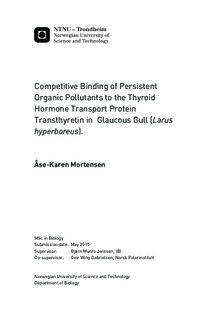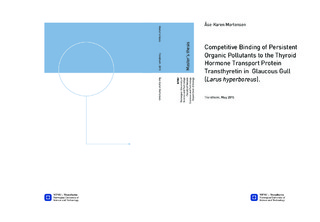| dc.description.abstract | The glaucous gull (Larus hyperboreus) is one of the largest avian top predators in the Arctic. High levels of persistent organic pollutants (POPs) and their metabolites have been detected in the glaucous gull, and several studies indicate that high levels of different POPs can contribute to detrimental effects. The mechanism behind these disruptions could be that chemicals interfere with the endocrine system. Thyroid hormones (THs) are important for thermogenesis, reproduction, growth and differentiation. They are transported in the circulation system of glaucous gull mainly bound to the transport proteins globulin, albumin and transthyretin (TTR). The aim of this study was to use molecular modeling to construct a homology model of the TTR in glaucous gull and to dock several well-known and new emerging POPs in the models to predict the binding affinity of POPs to the TH binding site in glaucous gull TTR.
The models predicted that a large group of structurally diverse compounds would bind to glaucous gull TTR such as polychlorinated biphenyls (PCB), hydroxyl-PCB (OH-PCB), methyl sulfone-PCB (MeSO2-PCB), polybrominated diphenyl ether (PBDE), OH-PBDE, methoxyl-PBDE (MeO-PBDE), bromophenols, 2-bromoallyl-2,4,6-tribromophenyl ether (BATE), bis-(2,4,5-tribromophenoxy)-ethane (BTBPE), allyl-2,4,6-tribromphenylether (ATE), 2,3-dibromopropyl-2,4,6-tribromophenyl ether (DPTE), triclocarban, triphenylphosphate (TPhP), 68399-95-1, 63734-62-3, 5059-77-9 and several perfluorinated compounds (PFCs).
The present of functional groups in the compounds like OH-groups were predicted to increase the binding affinity for the binding site, and if the functional groups were ionized then the binding affinity was predicted to further increased. However, the high scores of PBDEs indicate that functional groups are not necessary to bind to TTR. The models also predicted that brominated analogues had higher affinity to TTR than the corresponding chlorinated analogues. T3 were predicted to bind stronger to TTR than T4. The THs and the docked POPs were predicted to bind both in forward and reverse binding modes and had hydrogen-bonding interactions with the amino acids Lys15 and Ser117. The predicted binding affinityto TTR for some compounds like TBBPA were different from the results in studies of other species. This indicate that there is species-specific difference in binding to TTR. The docking of THs and the ROC-curves from the test set indicate that the constructed models of glaucous gull TTR are accurate in the predictions of whether a compound will bind to glaucous gull TTR or not.
Competitive binding of the POPs with THs for TTR in glaucous gull can potentially disrupt circulation of THs and possibly affect the TH homeostasis and TH-dependent functions. Many of the compounds predicted to bind to TTR have been detected in samples from glaucous gull or other seabirds from the Arctic. The POPs not yet detected should be measured in samples from glaucous gull. Further studies should investigate the binding affinity of the compound to TTR and their potential of competitive displacement of TH in the binding site of TTR in vitro. Studies looking at the potential biological effects on individual and population level of POPs binding to TTR are also necessary. | |

